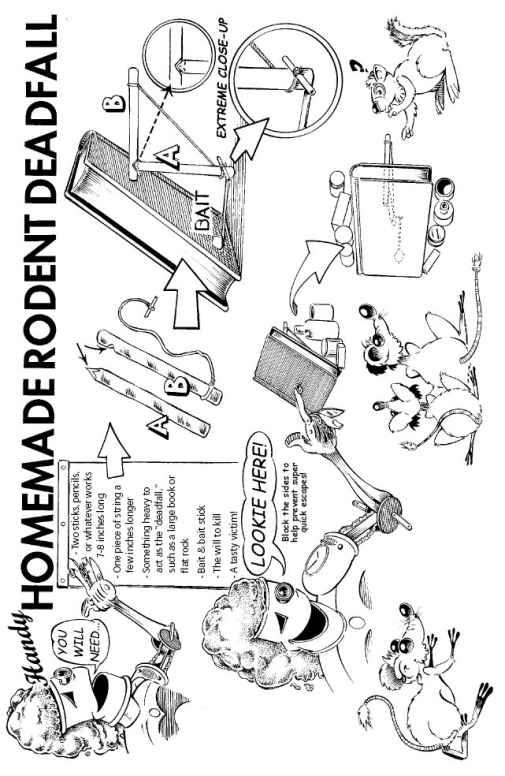When All Hell Breaks Loose (54 page)
Read When All Hell Breaks Loose Online
Authors: Cody Lundin
I personally have experimented with dried pinto beans (among several other things) that have been stored for more than fifteen years, still in the paper sack in which they were bought! Other than requiring a lot of soaking time and extra fuel to cook, they're fine. . .or are they? I don't have the resources to take my beans to the neighborhood laboratory and have them analyzed for nutritional content and microbes, as I'm sure is true for many other food storage "experts" who've undoubtedly experimented likewise. So I have fifteen-year-old pinto beans in a paper sack that are still edible, so what? I live in Arizona, land of limited moisture. How would that sack of pinto beans do in a closet in Washington state?
As with human nature and Mother Nature in a survival scenario, food storage is fraught with variables as to how the story will end. There is no question that following the rules of food storage will increase the shelf life of your stored food. How long it will really last is anyone's guess. Take all prophetic advice about how long your vittles will be vital with a grain of salt. The sure way out of this dilemma is to
rotate your food by storing what you eat and eating what you store
.
Bugs, Mice, and Rats:
It's What's for Dinner

When the times get tough, the tough look for alternative food sources. I don't like killing things for food, but I realize the importance of knowing how to do so if that's my only option. So do the students who take my classes on survival skills, some of whom have been vegetarians or vegans. Animal meat doesn't originate on a Styrofoam plate covered with plastic wrap. I'm convinced the world would have a lot more vegetarians if people who chose to eat meat had to kill it themselves. Doing so is an awesome responsibility and very humbling. That said, every urban, suburban, and rural area will have their share of smaller critters that hardy survivors can exploit to their advantage—bugs and rodents being the most common.
Eating What Bugs You
Eating bugs has gotten a bad rap, most recently from stupid television shows designed to shock people that seem to have nothing better to do. Most insects and bugs can be eaten and almost all contain a high amount of protein. Stay away from stinkbugs in the Southwest, caterpillars in general, and beware of insects that can hurt you such as bees, wasps, yellow jackets, and the like. Some insects should be cooked to kill potential parasites they carry, such as grasshoppers.
I realize your family will more than likely protest to worms being on the menu. Such an opinion is just that, an opinion based on cultural conditioning and being grossed out by the appearance of a foreign-looking creature. Bugs aren't gross; they just
look
gross to most people. If you knew the ingredients of a hot dog you would eat bugs. Most bugs and insects have a very mild flavor that can easily be disguised with spices or other food. Their shapes can be disguised by cooking and grinding them if necessary into a powder. This homemade protein powder can be added to soups and stews or something else to help your family achieve the nutrition they need—without the gross-out factor. If your survival food stash is getting low, cutting it with bugs will help extend the rations. For the most palatable results at the dinner table, think twice before telling other family members what you've done—and don't tell Vinny!
Remarkable Rodents

Mice and rats are extremely adaptable creatures. They are also easy to catch and kill with a little advanced preparation. My "Really Cool, Gotta Have It, Multiple Use Stuff" list presented later in the book includes traps for mice and rats. Rattraps are simply mousetraps on steroids. I have killed rats in mousetraps, and vice versa, but unless the mousetrap comes down on a vulnerable part of the rat's anatomy, you will more than likely lose your mousetrap to the rat. Unless the powerful critter gets stuck in a small space while trying to navigate with the trap attached to its body, it will disappear to a place only the rat knows about.
The most common mouse and rattraps are the Victor brand found at most hardware and grocery stores. There are two choices, the old-fashioned type with the metal bait area and the ones with the yellow plastic bait pad. The latter ones rely on a substance that's imprinted into the plastic itself to attract the rodent and don't require bait. These work okay when fresh, but they quickly lose their attractant, even when stored new within their original plastic. Even so, I like these the best, and use them successfully, even with no bait or commercial attractant left on the yellow pad. The answer to my success is easy if you think like a rodent. I place the loaded traps with the yellow pad nearest the wall, preferably right after or before a tunnel of some kind, such as a board propped up against the wall. Rodents are creatures of habit and love cruising along walls in the dead of night. If the wall also features some protective cover, such as our board example, all the better. The yellow bait pad has a large surface area and traps the rodent as it scurries across the trap, no bait needed.
Follow Robbie's instructions to make your own deadfall trap using everyday stuff around the house. Use caution with this trap as it can smash fingers and kill pets as well as rodents. To learn how to cook your critter, head to the Crucially Creative Cooking chapter.

In the strictest sense, stored emergency food should be treated as rations, not regular meals. Its main focus is to provide the survivor with sugar in order to minimize catabolism and dehydration and increase survival time.
At minimum, have a two- to four-week supply of stored food on hand for possible emergencies. This food should be easy to access, portable, require no cooking, and meet all of your nutritional needs. Don't forget to store food at the office and in vehicles as well.
If the power goes out, eat the food in the refrigerator first, and then the freezer. In a well-stocked, well-insulated freezer, foods will usually still have ice crystals in their centers—meaning they are safe to eat—for at least two days.
There are three macronutrients in foods:
carbohydrates, proteins, and fats
. All contain different amounts of calories, or stored energy, and "burn" or metabolize at varying rates within the body. Stored foods should contain all three macronutrients when possible for maximum nutrition and energy.
Of the three macronutrients, proteins require the most water from the body to metabolize. Avoid proteins and salty foods when water supplies are scarce.
Along with the nutritional content in quality food, salt and fats (cooking oils, etc.) are required for life. Fats are difficult to store for long periods of time but salt will store indefinitely.
Your basal metabolic rate (BMR) is the amount of calories you burn at rest doing no physical activity. Physiological factors that increase BMR are being male, young, tall, and muscular. Doing any physical activity whatsoever will increase the amount of calories you burn, as will certain illnesses and being in cold weather without adequate clothing or shelter.
Several factors will determine what your family chooses to store for food. These include the family's preference for what they like to eat, the supposed duration of the emergency, the age and health of family members, your home's unique storage environment, family finances, and pets.
Warning!
Don't take food storage for granted. Forced low-calorie diets of semistarvation will have far-reaching psychological and physiological effects. Leave living-off-the-land mythologies to Hollywood.
Be discreet about your food storage program and its location. It's no one's business but your family's.
There are several types of prepared foods that can be successfully stored. The more common options are canned goods, dried or dehydrated, freeze-dried, whole grains or legumes packed in buckets, and MREs (meals ready to eat). All have their pros and cons in preparation, cost, palatability, storage life, and nutrition.
Basic rules of food storage: Store what you eat, rotate what you store, store your food in the best possible conditions for maximum storage life using food-grade containers, and
keep things simple
.